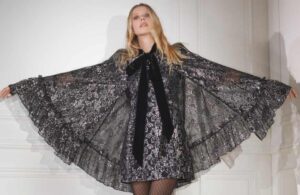
The sudden demise of the fashion label The Vampire’s Wife this month drove a stake through the heart of a cultural fairytale. The label’s combination of witchy creative flair, celebrity and retail luxury had caught the imagination of a miserable decade. It was founded in 2014 by the model turned designer Susie Cave and named after a novel abandoned by her husband, the musician Nick Cave.
Its ruffled frocks took only four years to become the stuff of royalty, on the Hollywood red carpet or at the wedding of Prince Harry and Meghan Markle (where three guests wore them). In 2020, they were accessorised for the Covid era with bespoke face masks; they also hit the high street in recycled silver nylon in a deal with H&M, selling out in 24 hours. Vogue made one design, the Falconetti, its “dress of the decade”, and a shimmering emerald green Falconetti was immortalised in paint in the first official portrait of the then Duke and Duchess of Cambridge.
This is a commonplace story of a small British label that lived and died by the laws of the market (the firm blamed supply chain upheavals, especially the collapse in March of the online stockist Matchesfashion). But it is also about fashion’s ability to capture the zeitgeist, often before other art forms have caught on. When people were Covid-confined, suffering immense hardship, they wanted the otherworldly glamour that a Vampire’s Wife dress projected. The singer Florence Welch said: “They make you look like you’re practising witchcraft in a very romantic cult.” This may explain why multiple appearances at the same high-profile event were not regarded as a fashion faux pas.
When the now Princess of Wales chose to pose in the Falconetti, she would have been well aware of its cultural resonance. That royal picture, by Jamie Coreth, has inserted The Vampire’s Wife into art history just as John Singer Sargent’s society portraits, currently at Tate Britain, did with the Parisian House of Worth. Its founder, Charles Frederick Worth, was in no doubt that fashion was an artform, grandiosely declaring: “I have Delacroix’s sense of colour and I compose. A toilette [a complete ensemble, from the French word toile, or cloth] is as good as a painting.”
Yet none of the Worth extravagances on display at the Tate say as much as a portrait Sargent made of wealthy New York newlyweds in 1897, which features the wife in practical walking garb, confidently posed, with hand on her hip. Her husband lurks behind like a faithful hound. In showing how the new woman might comport herself in the coming century, it was a precursor to the clothes of 20th-century designers such as Coco Chanel, Mary Quant, and perhaps the more mass market Biba’s Barbara Hulanicki, which defined and facilitated a new physical female freedom. Quant said a short skirt and opaque tights let a girl run for a bus, and described fashion as “a tool to compete in life outside the home”.
